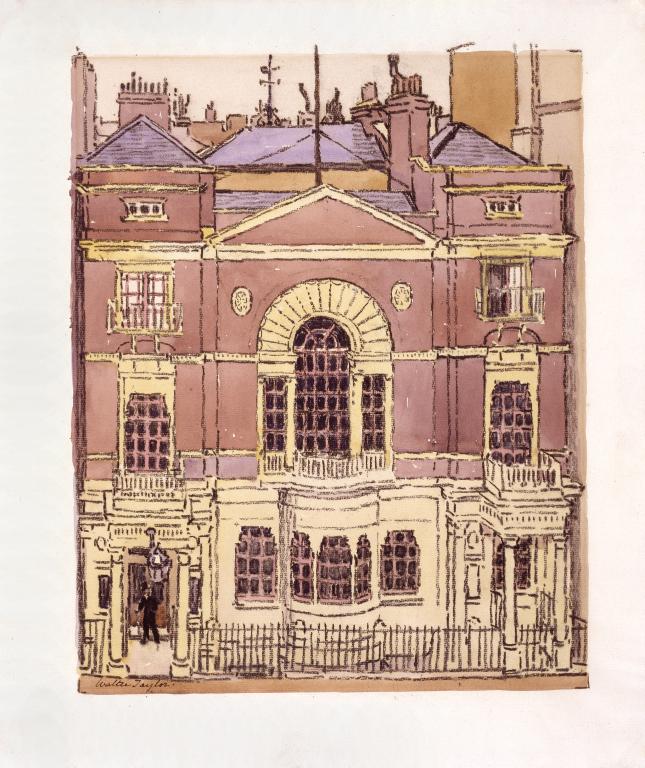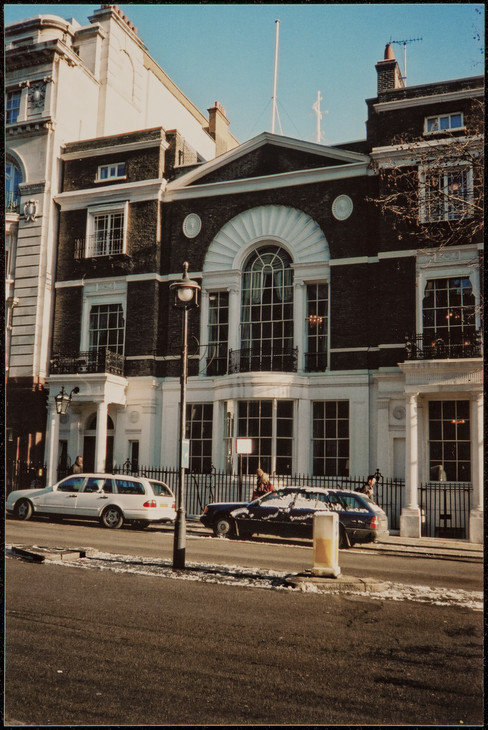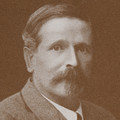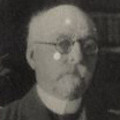Walter Taylor Boodle's Club c.1914-15
Walter Taylor,
Boodle's Club
c.1914-15
Walter Taylor trained as an architect and maintained an aesthetic interest in buildings. The composition of this charcoal drawing, showing the façade of the exclusive, upper-class Boodle’s Club at 28 St James’s Street, London, emphasises the symmetry of the building’s design. In the very shallow foreground, a gentleman in a top hat exits the porticoed entrance on the left-hand side.
Walter Taylor 1860–1943
Boodle’s Club
c.1914–15
Charcoal and watercolour on paper
478 x 404 mm
Inscribed by the artist ‘Walter Taylor.’ in black ink bottom left
Presented by the artist 1923
N03716
c.1914–15
Charcoal and watercolour on paper
478 x 404 mm
Inscribed by the artist ‘Walter Taylor.’ in black ink bottom left
Presented by the artist 1923
N03716
Ownership history
Presented by the artist to Tate Gallery 1923.
Exhibition history
1915
Second Exhibition of Works by Members of the London Group, Goupil Gallery, London, March 1915 (45).
1921
?Fourteenth Exhibition of the London Group, Mansard Gallery, London, May–June 1921 (88, as ‘Boodle’s’).
1922
Walter Taylor Oil Paintings and Watercolours, Goupil Gallery, London, May 1922 (4).
References
1944
W.J. Turner, ‘Walter Taylor’, in Water-colours by the Late Walter Taylor, exhibition catalogue, Leicester Galleries, London 1944, p.3.
1964
Mary Chamot, Dennis Farr and Martin Butlin, Tate Gallery Catalogues: The Modern British Paintings, Drawings and Sculpture, vol.2, London 1964, pp.713–14.
1973
David Buckman, Brighton Yesterdays: Douglas Fox Pitt 1864–1922 and Walter Taylor 1860–1943, exhibition catalogue, Maltzahn Gallery, London 1973, [p.1].
Technique and condition
Boodle’s Club is executed with charcoal and watercolour on off-white laid paper of medium weight. A watermark ‘Michallet/France’ at the bottom left, visible at the reverse indicates that it is of French origin. The paper retains three of its deckle edges with one cut straight, the sheet perhaps removed from a sketchbook. The image is drawn on the centre of the sheet. Taylor put four marks at each corner of the area to indicate where he was going to position the drawing, but did not enclose it within drawn margins. He confined the study to this area, initially drawing in charcoal and then applying watercolour and more drawing in charcoal over the watercolour. The charcoal is densely but neatly applied in all areas with no evidence of rubbing, although there are several finger marks and residues of charcoal in the margins.
Tomoko Kawamura
June 2005
How to cite
Tomoko Kawamura, 'Technique and Condition', June 2005, in Nicola Moorby, ‘Boodle’s Club c.1914–15 by Walter Taylor’, catalogue entry, February 2004, in Helena Bonett, Ysanne Holt, Jennifer Mundy (eds.), The Camden Town Group in Context, Tate Research Publication, May 2012, https://wwwEntry
Boodle’s Club in St James’s, London, is a non-political gentlemen’s club founded in 1762 which has been housed at 28 St James’s Street since 1783.1 The thoroughfare of St James’s Street connects Piccadilly at the north end and the royal residence of St James’s Palace at the south, and is the address of a number of private clubs including Brooks’, the Carlton Club, the Devonshire Club and White’s. Clubs such as these, particularly popular in the nineteenth century, provided a congenial venue for like-minded, upper class gentlemen to meet, socialise, eat, drink, gamble and play billiards. Membership then, as now, was strictly limited and only achieved through election. Women were not permitted to join.
It is likely that the exclusive, moneyed and establishment world of Boodle’s would have been complete anathema to the majority of the Camden Town Group members, who were largely from middle class backgrounds and, as young artists, struggled to make enough money to live. Their paintings focus on the lives of London’s working class population, shown in unpretentious lodgings and humble back streets. The sort of gentleman who would have been admitted to Boodle’s is convincingly, if simply, depicted in the watercolour by the figure just emerging from the entrance on the left. His top hat and cane are indicative of wealth and a certain conventional sobriety. As representatives of the avant-garde in London, even those members of the Camden Town circle who came from privileged backgrounds, such as Robert Bevan, would not have been interested in the conservative, established order of a gentlemen’s club. Walter Taylor was not a member of the Camden Town Group, but he frequented Fitzroy Street meetings and was later elected to membership of the London Group. His father was a successful tobacco manufacturer and Taylor himself was a man of considerable inherited wealth who, as well as living in Brighton, maintained a house in Oxford Square, off Hyde Park in London. Although he did not belong to a gentlemen’s club, Taylor’s comfortable lifestyle and bachelor-like existence suggest a certain affinity with that culture. Taylor painted watercolours of other gentlemen’s clubs, including the Reform Club in Pall Mall,2 and White’s, also in St James’s Street, which he exhibited with the London Group in May 1921.3
Since Taylor was not a member of Boodle’s it is likely that he chose the subject for its architectural interest. In his youth he had trained as an architect, and although he never practised he still retained an aesthetic fascination with buildings, particularly those from the Georgian and Regency periods; the majority of his paintings feature architectural subjects. The critic W.J. Turner, who wrote the introduction to Taylor’s memorial exhibition at the Leicester Galleries in 1944, recorded that ‘he was passionately interested in architecture, especially domestic, and would travel anywhere to see an old house which had any architectural feature of exceptional beauty’.4
Taylor’s watercolour shows the façade of the club-house viewed squarely from the front, possibly painted from the upper floor of the building opposite. Built in the ‘Adam style’ in 1775–6 by John Crunden (died 1828), the building is constructed of two bays with porticoed entrances on either side of a huge central Venetian window with an arched head, surmounted by a pediment. The front bay window at street level was added by John B. Papworth in 1821–4. The appearance of the exterior with its coloured brick and white pilasters, columns and motifs remains virtually unchanged today (fig.1). Even the flag-pole and weather-vane visible above the roof in the top centre of the painting are still in existence. Taylor’s choice of a flat, frontal perspective, completely filling the picture space and eliminating the foreground area, reveals the symmetry of the building’s design.
Boodle’s Club is a characteristic example of Taylor’s technique, which might be described as tinted drawing rather than watercolour painting. The artist has used carefully drawn, bold charcoal lines to record the appearance of the building. Watercolour has been carefully applied within this structured framework in clean, flat, unlayered washes. The use of colour is descriptive rather than emotive or expressive, and the interest of the image lies in the linear quality of the drawing and the patterns created by the building’s architectural features. Walter Sickert described Taylor’s watercolour method in a letter to his friend Ethel Sands:
Walter Taylor is staying with us which is a great pleasure. He works all day ... He does a kind of dashing large watercolour, always of well-placed subjects, well constructed, & always well composed, & in good colour. What is rather curious & interesting is that he puts dry cakes in pans & uses them as most people do moist pans, with a very large sable made of the quik of an eagle & costing 27 shillings!5
Taylor shared this technique with another London Group watercolourist, his friend and fellow Brighton inhabitant, Douglas Fox Pitt (1864–1922);6 their paintings from this period share a strong resemblance. The art historian Wendy Baron has also commented on the affinity of Taylor’s work with that of John Doman Turner (c.1873–1938).7 Turner was an amateur artist and member of the Camden Town Group (the only one not represented in Tate’s collection) who exhibited at all three of the Carfax exhibitions. A stockbroker’s clerk by profession, Turner received tuition in drawing and painting from Spencer Gore from 1908–13. As Turner was deaf, Gore instructed him through letters with written criticism on his drawings. In June 1911 Turner exhibited four pieces at the first Camden Town Group exhibition. It is known from their titles that two of these works had Brighton subjects, which Baron suggests may indicate a link with Taylor.8 Turner was possibly introduced to Taylor by Gore and, like other members of the Camden Town Group, may have stayed at Taylor’s house in Brighton. Turner tended to work in watercolour, pastel and pencil, but not in oils. Works, such as The Joy Wheel, Mitcham 1912 (fig.2), demonstrate the same use of bright colour applied over a firm charcoal outline drawing as Taylor. This technique was suggested by Gore who instructed him to ‘Use water colour as a transparent wash over a drawing, not getting the full colour but a tint with the relations of colour’.9 In another letter he noted, ‘It seems to me that charcoal and wash is better than pencil and wash. Pencil almost disappears, unless the wash is very light.’10
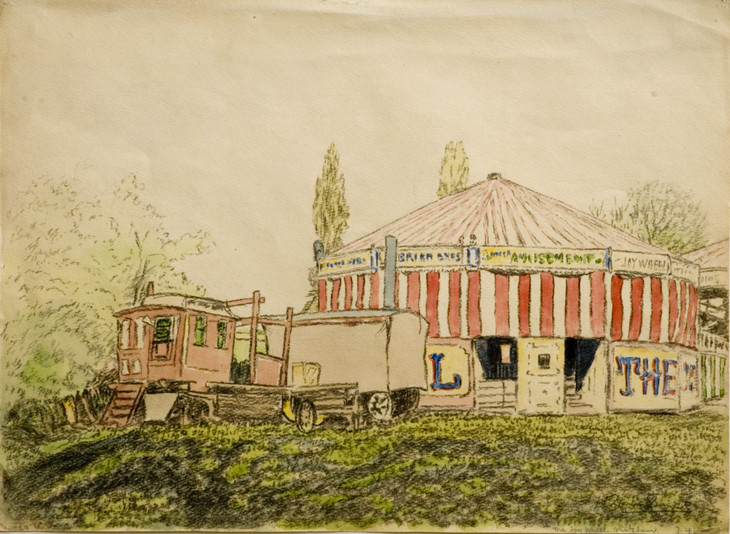
John Doman Turner c.1873–1938
The Joy Wheel, Mitcham 1912
Drawing, mixed media
381 x 280 mm
Southampton City Art Gallery
Photo © Southampton City Art Gallery, Hampshire, UK / The Bridgeman Art Library
Fig.2
John Doman Turner
The Joy Wheel, Mitcham 1912
Southampton City Art Gallery
Photo © Southampton City Art Gallery, Hampshire, UK / The Bridgeman Art Library
Nicola Moorby
February 2004
Notes
Modern British and Irish Paintings, Drawings and Sculpture, Sotheby’s, London, 10 March 1993 (lot 171).
W.J. Turner, ‘Walter Taylor’, in Water-colours by the Late Walter Taylor, exhibition catalogue, Leicester Galleries, London 1944, p.2.
Related biographies
How to cite
Nicola Moorby, ‘Boodle’s Club c.1914–15 by Walter Taylor’, catalogue entry, February 2004, in Helena Bonett, Ysanne Holt, Jennifer Mundy (eds.), The Camden Town Group in Context, Tate Research Publication, May 2012, https://www

